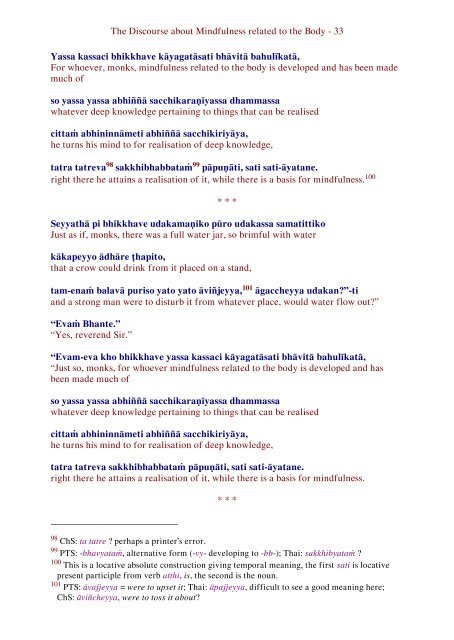Kayagatasatisuttam, the Discourse about Mindfulness related to the Body
A Pāli and English line by line (interlinear) version of this important discourse about the development of various meditations related to the body (together with extensive annotation).
A Pāli and English line by line (interlinear) version of this important discourse about the development of various meditations related to the body (together with extensive annotation).
Create successful ePaper yourself
Turn your PDF publications into a flip-book with our unique Google optimized e-Paper software.
The <strong>Discourse</strong> <strong>about</strong> <strong>Mindfulness</strong> <strong>related</strong> <strong>to</strong> <strong>the</strong> <strong>Body</strong> - 33<br />
Yassa kassaci bhikkhave kāyagatāsati bhāvitā bahulīkatā,<br />
For whoever, monks, mindfulness <strong>related</strong> <strong>to</strong> <strong>the</strong> body is developed and has been made<br />
much of<br />
so yassa yassa abhiññā sacchikaraṇīyassa dhammassa<br />
whatever deep knowledge pertaining <strong>to</strong> things that can be realised<br />
cittaṁ abhininnāmeti abhiññā sacchikiriyāya,<br />
he turns his mind <strong>to</strong> for realisation of deep knowledge,<br />
tatra tatreva 98 sakkhibhabbataṁ 99 pāpuṇāti, sati sati-āyatane.<br />
right <strong>the</strong>re he attains a realisation of it, while <strong>the</strong>re is a basis for mindfulness. 100<br />
* * *<br />
Seyyathā pi bhikkhave udakamaṇiko pūro udakassa samatittiko<br />
Just as if, monks, <strong>the</strong>re was a full water jar, so brimful with water<br />
kākapeyyo ādhāre ṭhapi<strong>to</strong>,<br />
that a crow could drink from it placed on a stand,<br />
tam-enaṁ balavā puriso ya<strong>to</strong> ya<strong>to</strong> āviñjeyya, 101 āgaccheyya udakan?”-ti<br />
and a strong man were <strong>to</strong> disturb it from whatever place, would water flow out?”<br />
“Evaṁ Bhante.”<br />
“Yes, reverend Sir.”<br />
“Evam-eva kho bhikkhave yassa kassaci kāyagatāsati bhāvitā bahulīkatā,<br />
“Just so, monks, for whoever mindfulness <strong>related</strong> <strong>to</strong> <strong>the</strong> body is developed and has<br />
been made much of<br />
so yassa yassa abhiññā sacchikaraṇīyassa dhammassa<br />
whatever deep knowledge pertaining <strong>to</strong> things that can be realised<br />
cittaṁ abhininnāmeti abhiññā sacchikiriyāya,<br />
he turns his mind <strong>to</strong> for realisation of deep knowledge,<br />
tatra tatreva sakkhibhabbataṁ pāpuṇāti, sati sati-āyatane.<br />
right <strong>the</strong>re he attains a realisation of it, while <strong>the</strong>re is a basis for mindfulness.<br />
* * *<br />
98 ChS: ta tatre ? perhaps a printer’s error.<br />
99 PTS: -bhavyataṁ, alternative form (-vy- developing <strong>to</strong> -bb-); Thai: sakkhibyataṁ ?<br />
100 This is a locative absolute construction giving temporal meaning, <strong>the</strong> first sati is locative<br />
present participle from verb atthi, is, <strong>the</strong> second is <strong>the</strong> noun.<br />
101 PTS: āvajjeyya = were <strong>to</strong> upset it; Thai: āpajjeyya, difficult <strong>to</strong> see a good meaning here;<br />
ChS: āviñcheyya, were <strong>to</strong> <strong>to</strong>ss it <strong>about</strong>?

















